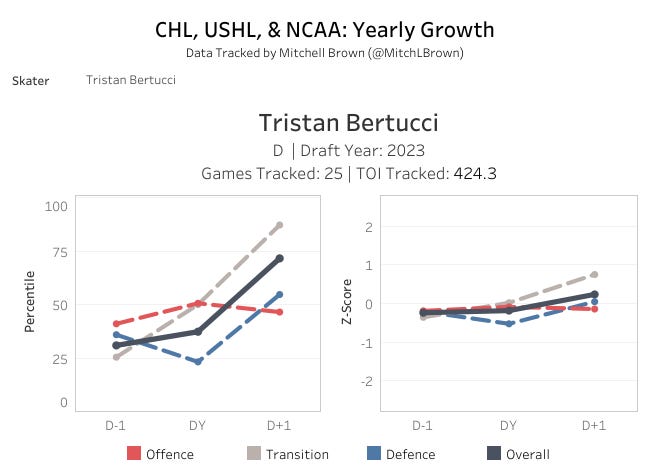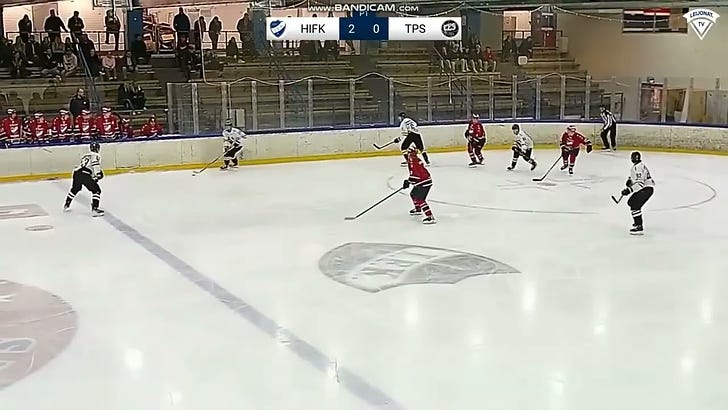With Logan Stankoven being Dallas’ most recent graduate, along with Mavrik Bourque and potentially Lian Bichsel on the way, the Stars have essentially emptied the cupboards. Everyone else is either a long shot, or a no shot. But every player is a story onto their own, and that’s part of the fun, so let’s dig right in!
August Rankings
I’ve divided the rankings into four essential tiers. Tier 1 and Tier 2 players follow a similar definition for me as above-replacement level players who can either be minute-heavy generalists, minute-light specialists, or vice versa. I define a ‘generalist’ as what it sounds like: impact players with a spectrum of broad skills while specialists work within a spectrum of specific ones. Wyatt Johnston, for example, is a generalist under these terms while Thomas Harley is more of a specialist. Neither term is meant to be pejorative. Next year I’ll have a more comprehensive definition of how my rankings and my general philosophy on drafting work in my own polluted head, but for now, hopefully it makes relative sense.
Tier 1 players have either the higher ceiling or the higher floor within these roles of generalist/specialist. Some Tier 2 players can be good enough to play in the NHL, but there may not be a clear path. See Ty Dellandrea and Nils Lundkvist.
Tier 3 players are the long shots, either profiling as minute-light generalist/specialists, or as replacement level players all around. Lastly, Tier 4 players are, for all intents and purposes, no shots. Either the talent’s not there to be an NHL player, or the path isn’t there. This is not meant as an insult. The NHL is not the center of the universe. Plenty of interesting, instructive hockey players exist outside of it.
And lastly, like anything else, players develop. That means that these tiers can develop too. Some get better, some get worse, some stay the same, but development happens at different rates for different players.
(1. — Tier 1) Lian Bichsel
I’m ranking Bichsel above Bourque because my hard and fast rule about prospects is the rule of First Principles: a top four defender > middle six forward each and every time. (This is also largely how I view and judge the draft; a position I consider way more sensible than viewing prospects through the lens of “BPA vs. Need”) We can debate whether Bourque is really the latter just like we can debate whether Bichsel is truly the former, but that’s what they were drafted to become. Bichsel was everything Dallas could have asked for in Texas (and Sweden) and then some.
Further reading: I did some film room analysis of him in November, which I think gives readers a real sense of his nuances.
Despite his temper, Bichsel plays a controlled game with the puck, profiling like a territorial defender rather than just a mere shutdown guy. His problem-solving game in all three zones will endear him to the team. His nastiness will endear him to the coaching staff.
(2.— Tier 1) Mavrik Bourque
With Bourque’s playmaking unleashed next to a fellow blue chip talent, he wasn’t just one of Texas’ best forwards; he was the best in the AHL once Stankoven graduated.
Further reading: this film room analysis really highlights Bourque’s development from smart playmaker to transition-dominant playmaker.
Bourque’s on-ice development was key too. His shot got stronger, as did his skating stride, creating a player adroit along the exterior and interior of the ice. A two-way playmaker is a rare breed, and one of the reasons why I’d have no problem with somebody ranking Bourque above Bichsel.
Further reading: David St. Louis’ prospect breakdown of him at EPRinkside is absolutely must-read material.
(3. — Tier 2) Emil Hemming
There’s a difference between not liking a pick, and not liking a player. Hemming was on my draft day big board at #4 among forwards, so hopefully that speaks for itself when you want to call me “whiny” just because — in my estimation — I think a top four defender is preferable to a middle six winger. Yes, Dallas deserves the benefit of the doubt, but no, that doesn’t shield them from criticism. (An especially bizarre refrain given what they just got for their 2018 first rounder.) So, no, I didn’t like the pick. In fact, I despised it. But the player I like, and how.
Further reading: missed all the scouting reports of highlights of Dallas’ latest first round pick? Read on!
Hemming has all the tools to be a strong, possession-heavy middle six right winger. Between his ability to finish and forecheck while playing responsible 200-foot hockey, Hemming instantly becomes the best winger in Dallas’ system. It’s great to have a ton of centers, but you need specialists too, and Hemming, in addition to being said specialist, also adds size and speed to a system lacking in both.
(4. — Tier 2) Aram Minnetian
I was a huge fan of Minnetian when he was drafted. Transitioning into a college program (Boston College) this year with marquee names like Will Smith (San Jose), Cutter Gauthier (Anaheim), and Ryan Leonard (Washington), he was never gonna lead the way on the blueline. As a result, his underlying data took a hit.

He went from being an elite transition defender to a very good one, and his offense cratered. However, his defense got better, and that’s all that matters, because defense is how he’ll break through. It’s been said that Minnetian doesn’t have “standout” skills, but I disagree. I think his skating is pitch perfect: just the right blend of straight-line speed and agility to change tempo. Of all the players outside of Dallas’ Tier 1 to earn a potential roster spot and make a real impact, Minnetian is my darkhorse pick.
(5. — Tier 2) Christian Kyrou
Kyrou was frustrating to watch in Texas precisely because it was his strengths that kept failing him. Flat-footed puck movers (Wheeler has called Kyrou “smooth-skating” so depending on which Eye Test you take, this is either a strength or a flaw) don’t have it easy. Defending tends to be their weakness, but Kyrou’s issue was that he defended poorly and struggled to do anything of note offensively. Luckily Kyrou began to put it all together as the season progressed, and then straight up showed out in the Calder Cup playoffs. His path is tough, but pound for pound, Kyrou’s offensive potential as as good as any of Dallas’ top prospects.
(6. — Tier 3) Arno Tiefensee
Tiefensee doing what he’s been doing in a man’s league for a playoff-caliber team should be talked about more.
(7. — Tier 3) Ben Kraws
Ben Kraws was signed out of college as a Hobey Baker candidate from St. Lawrence University, finishing his collegiate campaign with a .919 save percentage. In only a very limited AHL appearance, (six games total, four in the regular season) he made an impression as a calm, confident netminder.
(8. — Tier 3) Remi Poirier
The former 6th round pick from 2020 finished with a .904 save percentage after dominating in the ECHL with the Idaho Steelheads. Upon making the jump, there were times when he seemed totally ready to transition, and times when he seemed totally overwhelmed.
(9. — Tier 3) Ayrton Martino
Martino has been one of Dallas’ darkhorse prospects for years. While he took a step back, production wise (going from 38 points in 37 games to 27 points in 31 for Clarkson University), he’s still one of Dallas’ best as a playmaking winger.
(10. — Tier 3) Tristan Bertucci
I’m gonna try not to make it a habit of talking about the players Dallas passed on, but between EJ Emery this year, and Hunter Brzustewicz last year, the Stars lost their appetite completely for right-shot defensemen after shotgun drafting them in 2022. On the surface, Bertucci took a step back, going from 50 points in 63 games to 44 in 61 — both times for the Flint Firebirds (will somebody please tell Stars scouts to stay away this cursed team). However, Mitchell Brown’s manually tracked three-zone data tells a very different, and more encouraging, story.

On the contrary, he had a glow-up! His future is probably more Mattias Backman than Brenden Smith, but he’s a player that’s developing along just fine. I’d rank him higher, but his path to the NHL is a tough one.
(11. — Tier 4) Gavin White
I’m looking forward to White’s development. Injuries derailed his season, but he’s one of Dallas’ better athletes — the best way to describe his game, for better and worse. I have White higher than most, but I also recognize that he’s an older prospect (he’ll be 22 in November), which means his reads and anticipation need to catch up to his legs sooner rather than later. If they do, suddenly we’re cooking with more than just the social media harassment of Sean Shapiro. (Also, who are you people?!)
(12. — Tier 4) Luke Krys
Signed out of the NCAA (Providence College) after graduating, the 6’2 shutdown defender instantly became a young Alex Petrovic on Texas’ blueline. I was very very pleasantly surprised. The modern stay-at-home defender needs to have some skill in the defensive zone, and not just physicality, and Krys has that; albeit in small doses.
(13. — Tier 4) Kyle McDonald
McDonald surprised me with his power forward frame, and short king’s hands. The problem with McDonald is that there are times he needs to switch between one or other. Instead he plays like he’s always Stankoven. As an older prospect, I wouldn’t expect much, but he’s a solid AHL contributor.
(14. — Tier 4) Antonio Stranges
Stranges had a funny year. He was productive in a super limited role, but to what end? The coaches didn’t trust him (although this could also be interpreted as the coaching staff bringing him along slowly) but it was paradoxically hard to see why, and easy to see why. One of the most instructive plays was this one:
Stranges is an interesting player because the talent’s there, and so is the work. But that just goes to show you that there’s more to being successful than raw talent and hard work: now more than ever, it’s about being smart. In a weaker system, Stranges might go up a tier. 11 goals in a super limited role is already impressive.
(15. — Tier 4) Angus MacDonell
The scrappy center had a hell of sophomore season for the Mississauga Steelheads. He went from 24 points in 31 games in a minor role to 62 points in 61 games in a more prominent role. However, the underlying numbers were a lot less kind.

He still grades out as an above average prospect with an edge, making him one of Dallas’ more interesting prospects.
Rankings
Tier 1
Lian Bichsel
Mavrik Bourque
Tier 2
Emil Hemming
Aram Minnetian
Christian Kyrou
Tier 3
Arno Tiefensee
Ben Kraws
Remi Poirier
Ayrtom Martino
Tristian Bertucci
Tier 4
Gavin White
Luke Krys
Kyle MacDonald
Antonio Stranges
Angus MacDonell









So David , you see the SWISS HAMMER as a possible 2nd coming of a Chris Tanev / Darian Hatcher type ! NICE !!!
Derek Neumeier reposted comments regarding Hemming at the World Junior Showcase which said he was a top performer on the Finnish team.